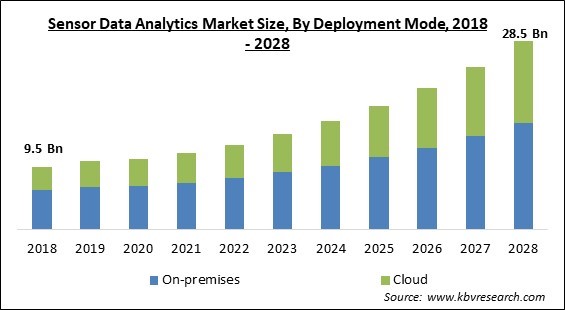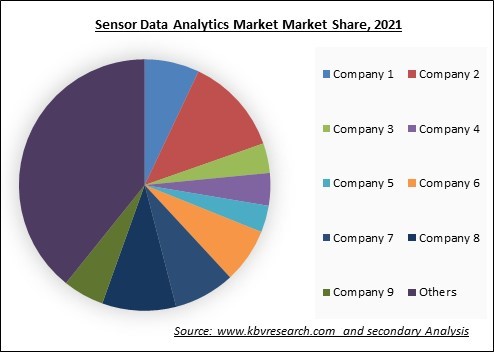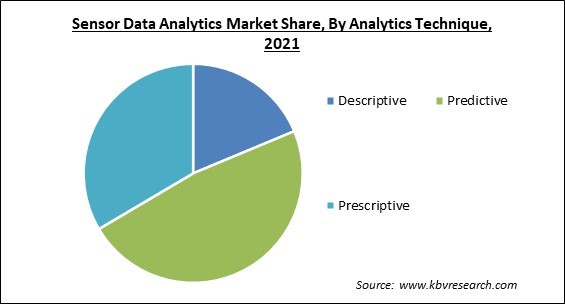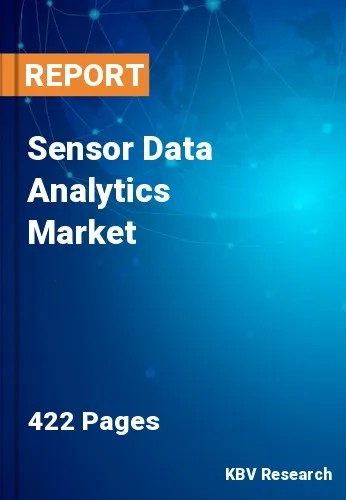The Global Sensor Data Analytics Market size is expected to reach $28.5 billion by 2028, rising at a market growth of 14.2% CAGR during the forecast period.
A key statistical method for gathering and assessing data that was first derived from the most recent sensor in real-time is called sensor data analytics. Additionally, modern wireless sensors or wired sensors can produce valuable data in significant amounts. Identifying abnormalities is the most significant objective or technique of sensor data analytics, and this real-time data can be used for a variety of contemporary applications. When a machine fails during production or a patient's health suddenly declines, these accidents can be rapidly and easily tracked and prevented from having big, negative effects.

Industries are flooded with petabytes of Big Data because of the growth of the Internet of Things (IoT), which is made up of an expanding number of wired and wireless sensors. These sensor networks continuously track and report on crucial data, such as patient heart rates, oil drill production flow, or hydropower plant turbine wear. By developing models to extract the insight hidden in this wealth of data, sensor data analytics assist industries in making the most of it. This knowledge transformation of business operations enables people to predict disease, lower maintenance costs, foresee equipment breakdowns, etc.
Analytics of sensor data will be crucial to the success of any firm. All industries, including mining, green technology, and software development, will rely heavily on sensors in the future. Sensors are devices that can gather data, which is then stored in data lakes and processed further by data analytics programs. Analytics tools are designed to examine data flowing from these devices because IoT is expected to establish a major footprint all over the world.

The leading players in the market are competing with diverse innovative offerings to remain competitive in the market. The below illustration shows the percentage of revenue shared by some of the leading companies in the market. The leading players of the market are adopting various strategies in order to cater demand coming from the different industries. The key developmental strategies in the market are Acquisitions, and Partnerships & Collaborations.
The COVID-19 pandemic significantly impacted a number of industries all over the world, including the sensor data analytics market. This is linked to the majority of governments putting their citizens on lockdown and prohibiting all international travel to stop the spread of the virus. However, after the pandemic ended and the market for sensor data analytics recovered, the market is estimated to grow. The need for cloud-based sensor data analytics to manage key information of enterprises is increasing as a result of numerous organizations introducing a culture of work-from-home for their employees. This is a lucrative prospect for market expansion in the coming years.
With the increasing penetration of modernization and urbanization all over the world, the demand for smart wearables is rapidly increasing. Smart wearables are increasingly becoming a market trend, owing to which, a number of people all over the world are adopting this modern-era technology, such as wrist, body, and eyeglasses, in healthcare and consumer entertainment. Additionally, the technology for wearable products has advanced gradually, and the gadgets are getting smaller, which has led to numerous manufacturers applying this technology worldwide.
As people are Advancing toward a more technological and sophisticated world, the need for upgrades and advancements in prevailing technologies are also required. In order to address this demand, market players all over the world are bringing to the market, a significant number of new and advanced sensors with a number of benefits for customers. High-speed and inexpensive electronic circuits, signal processing techniques and new manufacturing technologies are driving the advancement of sensor technology.
Nowadays, people are surrounded by an increasing number of sensors that are integrated into wearable technology, smart energy meters, and other connected devices that delve further and deeper into their personal life. Other sensors are less protected and less of a concern, although some are frequently viewed as privacy-sensitive and always need user permission to be engaged. However, a variety of seemingly harmless sensors can be used to deduce highly sensitive information about nearby people.
On the basis of Deployment Type, the Sensor Data Analytics Market is divided into On-premise and Cloud. In 2021, the on-premise segment registered the biggest revenue share of the sensor data analytics market. The rise in the growth of the segment is attributed to the fact that the on-premise deployment of sensor data analyzers increases the safety and privacy of the data. The cloud sometimes can be prone to unauthorized invasions.
Based on Analytic technique, the Sensor Data Analytics Market is segregated into Descriptive, Predictive, and Prescriptive. In 2021, the predictive segment procured a substantial revenue share of the sensor data analytics market. A subset of advanced analytics called predictive analytics uses historical data along with statistical modeling, data mining, and machine learning to forecast future results. Utilizing trends in this data, businesses use predictive analytics to spot dangers and opportunities.
By Tool Type, the Sensor Data Analytics Market is segmented into Dashboard & Data Visualization, Data Mining & Warehousing, Self-Service Tools, Reporting, and Others. In 2021, the dashboard and data visualization segment witnessed the largest revenue share of the sensor data analytics market. A dashboard is a tool for data visualization that monitors, evaluates, and presents metrics, KPIs, and important data points. Users of all skill levels may utilize dashboards to comprehend business intelligence and use it to make better decisions. Due to the increased precision of this tool, the growth of the segment is being propelled.

By Component, the Sensor Data Analytics Market is categorized into Hardware, Software, and Service. In 2021, the services segment accounted for a substantial revenue share of the sensor data analytics market. The rise in the growth of the segment is due to the fact that these services cut down on the time and costs involved in system optimization during the initial phase of deployment. In addition, these services are mainly employed in large enterprises in order to save time and cost on several business operations in the sector. Therefore, the growth of the segment is stimulating.
Based on Model, the Sensor Data Analytics Market is bifurcated into Ad-hoc Sensor Analytics and Real-time Sensor Analytics. In 2021, the Ad hoc sensor segment acquired the largest revenue share of the market. Ad hoc sensor data analysis refers to investigating the sensor data as per the requirements of the examiner. It allows the examiner to offer the best possible output. It is typically carried out by a group of data scientists or analysts. Ad hoc sensors are typically used in large enterprises.
On the basis of Organization Size, the Sensor Data Analytics Market is divided into Large Enterprises and Small & Medium Enterprises (SMEs). In 2021, the SMEs segment registered a substantial revenue share of the sensor data analytics market. The surge in the growth of the segment is majorly attributed to the increasing efforts of small and medium organizations to accelerate the process of their growth. SMEs can leverage sensor data analytics in order to examine and streamline a huge amount of complex data.
Based on Vertical, the Sensor Data Analytics Market is classified into Manufacturing, Aerospace & Defense, Energy & Utilities, Government, Healthcare & Life Sciences, Transportation & Logistics, Retail, and Others. In 2021, the manufacturing segment witnessed the largest revenue share of the sensor data analytics market. The growth of the segment is mainly owing to the increasing demand for sensor data analytics within the automotive industry. To find traits that indicate a purchase, automakers can examine their current clientele.
| Report Attribute | Details |
|---|---|
| Market size value in 2021 | USD 11.6 Billion |
| Market size forecast in 2028 | USD 28.5 Billion |
| Base Year | 2021 |
| Historical Period | 2018 to 2020 |
| Forecast Period | 2022 to 2028 |
| Revenue Growth Rate | CAGR of 14.2% from 2022 to 2028 |
| Number of Pages | 422 |
| Number of Tables | 750 |
| Report coverage | Market Trends, Revenue Estimation and Forecast, Segmentation Analysis, Regional and Country Breakdown, Competitive Landscape, Companies Strategic Developments, Company Profiling |
| Segments covered | Component, Model, Organization Size, Tool Type, Analytics Technique, Deployment Mode, Vertical, Region |
| Country scope | US, Canada, Mexico, Germany, UK, France, Russia, Spain, Italy, China, Japan, India, South Korea, Singapore, Malaysia, Brazil, Argentina, UAE, Saudi Arabia, South Africa, Nigeria |
| Growth Drivers |
|
| Restraints |
|
Region-Wise, the Sensor Data Analytics Market is analyzed across North America, Europe, Asia-pacific, and LAMEA. In 2021, North America held the largest regional share of the sensor data analytics market. The growth of the segment is rising as a result of developments in the information and communication technology (ICT) industry as well as the rapid adoption of artificial intelligence (AI) and the internet of things (IoT) across various industries. The regional countries are among the early adopters of advanced technologies, which is majorly boosting the growth of the regional market.
Free Valuable Insights: Global Sensor Data Analytics Market size to reach USD 28.5 Billion by 2028
The market research report covers the analysis of key stake holders of the market. Key companies profiled in the report include Microsoft Corporation, IBM Corporation, SAP SE, Tata Consultancy Services Ltd., Schneider Electric SE, Hewlett Packard Enterprise Company, Cisco Systems Inc., Qualcomm Inc., Verizon Communications, Inc., and Talend S.A. (Thoma Bravo)
By Deployment Mode
By Analytics Technique
By Tool Type
By Component
By Model
By Organization Size
By Vertical
By Geography
The Sensor Data Analytics Market size is projected to reach USD 28.5 billion by 2028.
The Emerging Trend of Smart Wearables All Over the World are driving the market in coming years, however, Privacy Risks Associated With the Use of Sensors restraints the growth of the market.
Microsoft Corporation, IBM Corporation, SAP SE, Tata Consultancy Services Ltd., Schneider Electric SE, Hewlett Packard Enterprise Company, Cisco Systems Inc., Qualcomm Inc., Verizon Communications, Inc., and Talend S.A. (Thoma Bravo)
The Hardware market has shown the high revenue share in the Global Sensor Data Analytics Market by Component in 2021, and would continue to be a dominant market till 2028; thereby, achieving a market value of $11.6 billion by 2028.
The Large Enterprises market is leading the Global Sensor Data Analytics Market by Organization Size in 2021, thereby, achieving a market value of $18.5 billion by 2028.
The North America market dominated the Global Sensor Data Analytics Market by Region in 2021, and would continue to be a dominant market till 2028; thereby, achieving a market value of $9.7 billion by 2028.
Our team of dedicated experts can provide you with attractive expansion opportunities for your business.

